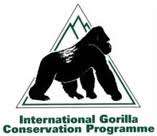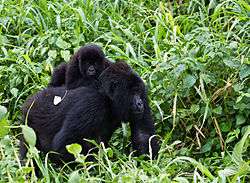International Gorilla Conservation Programme
 | |
| Formation | 1991 |
|---|---|
| Type | INGO |
| Purpose | Environmental protection |
Region served | Africa |
Director | Eugène Rutagarama |
| Website |
www |
Formerly called | Mountain Gorilla Project |
The International Gorilla Conservation Programme (IGCP) was formed in 1991 to ensure that the critically endangered mountain gorillas are conserved in their habitat in the mountain forests of the Virunga Massif in Rwanda, Uganda and the Democratic Republic of the Congo.[1]
Origins
The programme grew out of the work of Dian Fossey, who began to study Rwandan mountain gorillas in the 1960s. African Wildlife Foundation (AWF) President Robinson McIlvaine later said that "There would be no mountain gorillas in the Virungas today ... were it not for Dian Fossey's tireless efforts over many years".[2] McIlvaine initiated formation of the Mountain Gorilla Project in 1979, the predecessor to the IGCP, while he was president of the AWF.[3] The International Gorilla Conservation Programme was formally established in 1991 by the AWF, Fauna & Flora International and the World Wide Fund for Nature.[1]
During the ongoing and linked conflicts of the Rwandan Civil War (1990-1993) followed by the Rwandan Genocide of 1994 and the Second Congo War (1998-2003) the best that could be done was to attempt to support park workers, many of whom lost their lives.[1]
Activities
The International Gorilla Conservation Programme works with the Rwanda Development Board, the Uganda Wildlife Authority and the Institut Congolais pour la Conservation de la Nature. The IGCP tries to gain support for conservation among the local communities, and to ensure that the protected area authorities collaborate with these local communities.[1] Among other activities, the IGCP works with Virunga Artisans, which markets handmade products of artisans who live near the Volcanoes, Mgahinga and Bwindi National Parks.[4] A census of mountain gorillas in the Virunga Massif in March and April 2010 showed that there had been a 26.3% increase in the population over the past seven years, an encouraging sign that conservation efforts were succeeding.[5]
See also
- Mgahinga Gorilla National Park
- Bwindi Impenetrable National Park
- Rwenzori Mountains National Park
- Virunga National Park
- Volcanoes National Park
References
Sources
- "About the International Gorilla Conservation Programme". The International Gorilla Conservation Programme. Retrieved 2011-10-20.
- "About Virunga Artisans". Virunga Artisans. Retrieved 2011-10-15.
- "Celebrating AWF's 40th Anniversary". African Conservation Foundation. Retrieved 2011-10-18.
- Masozera, Anna Behm (December 7, 2010). "Census confirms increase in population of the critically endangered Virunga mountain gorillas". Greater Virunga Transboundary Executive Secretariat. Retrieved 2011-10-15.
- "Robinson McIlvaine 1913 - 2001". AWF. Retrieved 2011-10-18.

